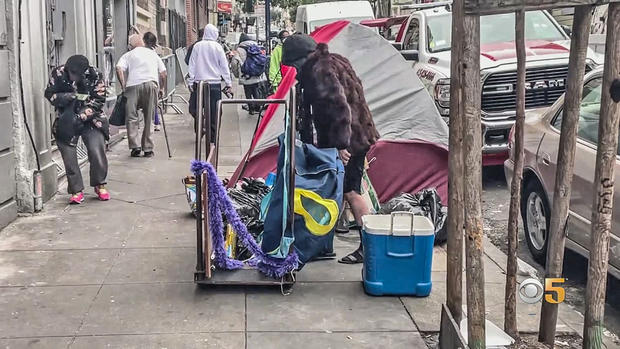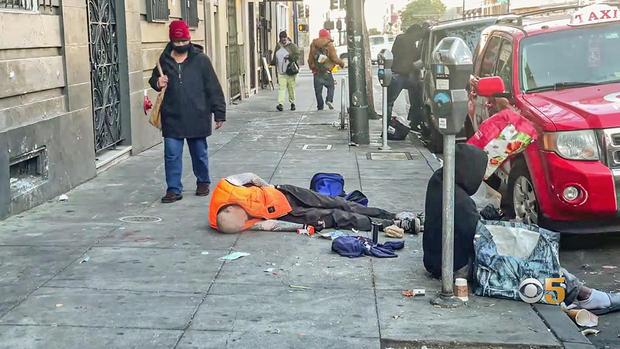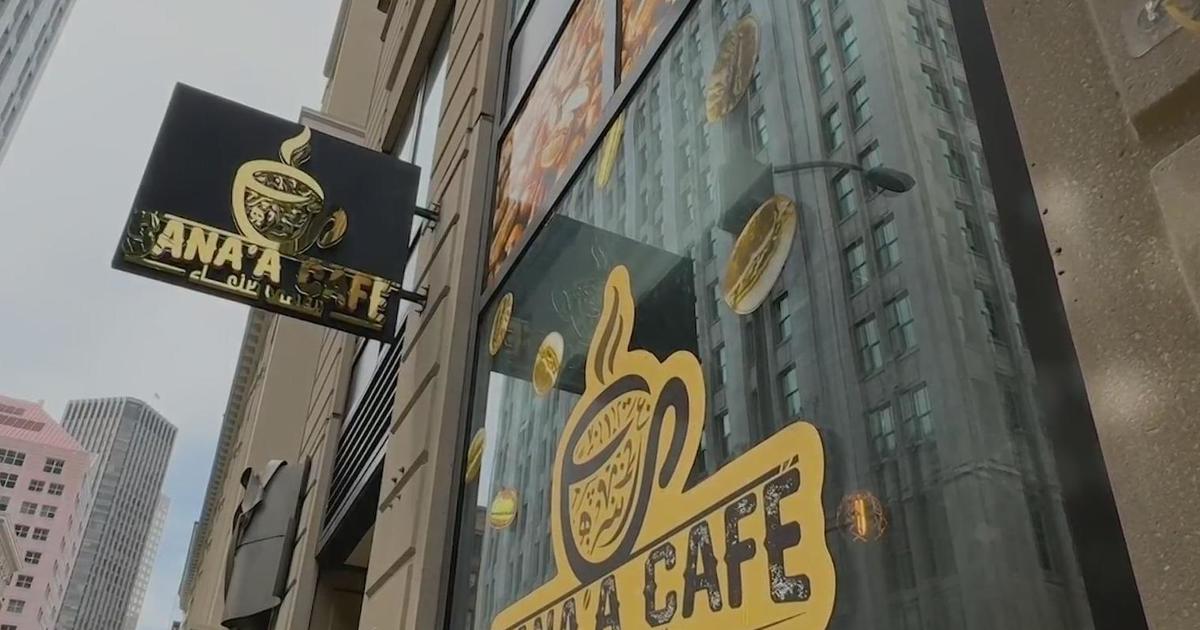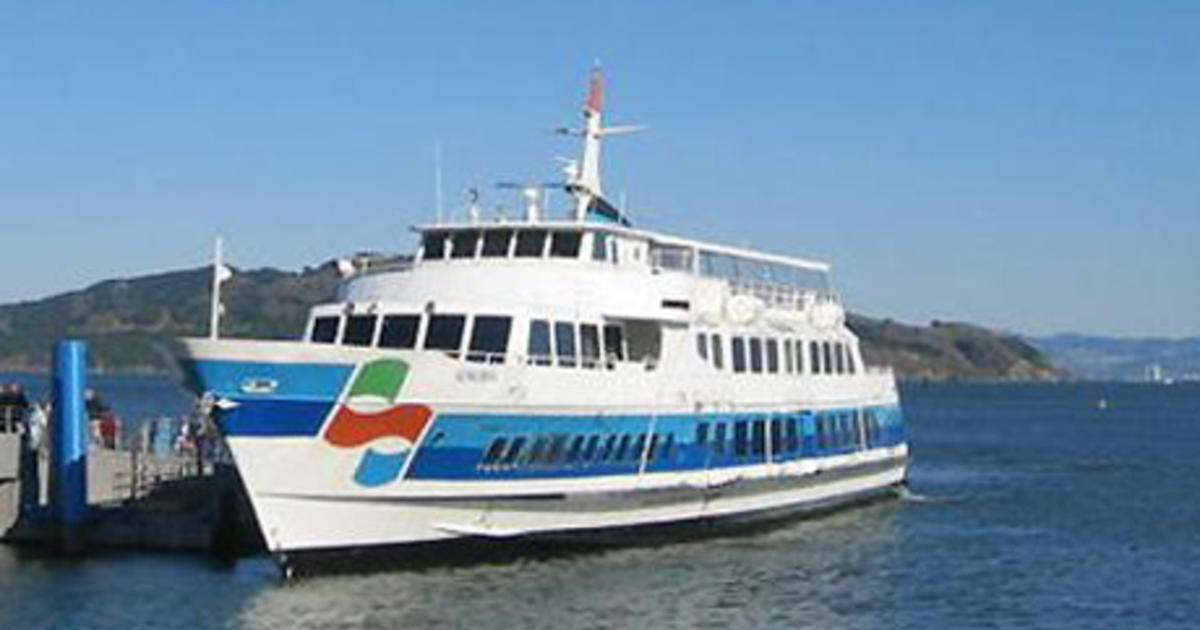KPIX Special Report: San Francisco Tenderloin – A State of Emergency
SAN FRANCISCO (KPIX) -- The state of emergency that San Francisco Mayor London Breed declared for the Tenderloin last December has a lot of people talking but no one is paying closer attention than the people who live there. There are some who expect major improvements and many others who are skeptical that there will be much change at all. Still the question on everyone's mind is: Can the city clean up the Tenderloin?
"We've got Urban Alchemy coming out here every morning," said neighborhood resident Johnny Douglas. "They have brooms, trash cans, plastic bags. They get to work and get at it. Load them up and get busy."
For those who live and work in this neighborhood, it is just another day in a state of emergency.
Parents like Maggy Fungula will have to get their children to school, with or without an organized escort.
"Sometimes I've got to go out in the street with my baby," Fungula said of the drug dealing and drug use. "I don't want my baby to see that environment."
Neighbors like Alex Alvarado will spend another day trying to keep that environment at bay.
"My territory is my territory, man," Alvarado explained. "And I tell them both -- both the users and the dealers -- I don't want the drugs in front of my door."
Then there are the thousands, at least 8,000 people without homes in the city, many of them living along the alleys and sidewalks of this neighborhood.
"That's a long story," said a tent-dweller who gave her name as Jasmine as she moved her tent for a sidewalk cleaning crew. "That's a 27-year-old story. Where are you from? Originally? I'm from Fairfield."
Street-cleaning program provides a temporary sense of relief
Walk one block, there are signs of improvement. Walk another, it's encampments and people in obvious distress with seemingly no intervention at all. The Tenderloin is emblematic of a city wrestling with a housing crisis decades in the making.
"These are very entrenched problems, both at a community level and an individual level," said Mary Ellen Carrol, Director of Emergency Management, currently in charge of carrying out the operation launched in December by Breed.
"We are trying to raise the bar for the Tenderloin, for everyone who is there," Carrol says. "And what we hear from the community is that they are pleased to see some things happening and they need to see more."
"I've seen an improvement in cleaning the streets, in washing the sidewalks," said restaurant owner Stoudane Barkouki.
Neighbors are giving out some high marks in one regard and that is the cleaning blitz. Finding a street blocked for a pressure-washing crew is part of daily life here now and a lot of neighbors love it.
"Having a clear path, to be able to see a couple of blocks down, is a blessing," Alvarado said after a cleaning crew moved through.
"They clean up everything but, after one hour, they come back and garbage is everywhere," Barkouki observed. "They have to be on a daily basis."
"It just keeps continuing, over and over again," said Tony Kushmaul. "It's a weird situation of doing the same thing over and over again, nothing really corrects the problem."
Cleaning the streets and sidewalks was never going to be the hard part. The trash is largely a byproduct of the city's larger, longstanding problems that have been pushed into this neighborhood: homelessness and a drug epidemic that has claimed more than 1,360 lives in the past two years.
"You know, there's people, you look around, people look like zombies," Carrol says. "They are human beings. They are someone's son, someone's daughter, someone's husband, mother or father."
So the emergency continues as neighbors watch and ask their own questions about what's being done, what comes next.
"Where are you going to push them to?" asked Alvarado. "They have to go somewhere. You have to have a place for them."
Ask neighbors what they think it will take to make a difference here and the answer is often a simple one.
"A lot of help," Fungula says. "A lot of help."
PART TWO
One main objective of the Tenderloin State of Emergency declaration was to accelerate the delivery of help to those who need shelter or treatment. It is a vast, complicated undertaking.
"Well they tell us we have to move every day," said street resident Jasmine, as she once again was asked move her tent. "At least twice a day. They'll come back at 2:30 and do it again."
Another day, another pressure-washing on the 300 block of Hyde Street and that means Jasmine will be packing up and making way for Emergency Management, Public Works and a team of outreach workers.
"They're trying to help everybody that they can," she says of the outreach teams. "I mean, how much help it might be is another story, right? But they're offering it."
"Well, what they have done for me, is they are providing me an opportunity for housing," said Gordon, who got help from the centerpiece of this initiative -- the Tenderloin Linkage Center in Civic Center Plaza, which has been open for about seven weeks.
"At the beginning of this, we didn't even know if people would show up," said Mary Ellen Carrol, director of Emergency Management.
With more than 20 people often in line when the doors open at 8 a.m., the center is seeing plenty of traffic, more than 13,000 visits since day one. That number includes repeat visitors. Guests are not registered and don't give their last names. This is, basically, a referral center, designed to pull those in need toward the city's existing services.
"Try to build a relationship, trust," Carrol explained. "And provide options that are humane and give people a path."
The path many are looking for is off the street. So far -- between street outreach and the linkage center -- more than 400 people have been moved into some kind of shelter.
"They gave me the tent city over there for about a year," said Lee, who is one example, having recently moved out of a nearby sleeping village that the city is dismantling.
"A little hotel room over on Eddy Street," he says of his new spot.
"Fixing to pack my stuff up, take it to storage and take my backpack and go upstairs to my place," Jasmine said of her next move.
Jasmine may not always use it but she too now has a room provided by the city. There is not, however, an infinite supply of rooms.
"Absolutely not," said Sara Shortt, director of Public Policy for HomeRise, a nonprofit housing organization. "I mean, that's why they're there in the first place. There is simply not enough housing to match the need."
Like many service providers, Shortt questioned this plan from the outset.
"I thought 'how are they magically going to be able to address all of the problems of the Tenderloin' when, so far, they have not been able to do that in the rest of the city," Shortt said.
That is one line of criticism -- that all of this amounts to pushing people toward help that cannot meet demand. Then there is another faction of critics -- those who question the approach to the drug problem. The big flash point there, of course, is the decision to allow drug use here.
"The bottom line is that they're not going to have the desired outcome that they wanted when they opened this linkage center," said recovery advocate Tom Wolf.
Wolf battled a heroin and fentanyl addiction until his eventual arrest and recovery. He has become the face of the city's growing push for more recovery options.
"The linkage center has enough low-barrier services already available that it's OK to ask people to put their drugs in their pockets for an hour while they come in and access services, potentially housing or treatment, whatever it is," Wolf said.
"I mean it's good in a sense that they provide services," said one visitor named Patrick. "The services are directly available to you when you're there."
Even some of those looking for help expressed similar concerns. Patrick is from Calaveras County. He's been in San Francisco for about three weeks.
"You get stuck at the linkage center," he said. "Because there's drugs and you want to do the drugs. So you'll sit there and do drugs all day and you procrastinate."
Looking at the latest week of numbers, there were nearly 2,700 visits but only 144 referrals for services. A referral means a guest was told how to get help but there's no way of knowing if they followed through and connected to it. Of those referrals, nine were for substance abuse treatment. In the same week, four visitors had overdoses reversed on-site.
"At the end of the day, it is not about quantity, it's about quality," Breed said. "It's about trying to help those people out of addiction and stay out of addiction and that's a process. So people may want us to do numbers and large numbers, like it's some kind of a factory. But these are people. These are people with complicated problems in their lives and we're trying to provide the solutions."
The mayor has promised to push harder on troublesome street behavior of all kinds and that push is said to be coming.
"You're in shelter, you have a place to go," Carrol said of the plan to be more assertive. "If you're still exhibiting these behaviors in the street, that's really not acceptable. In the future, we will need to have our law enforcement partners more involved."
PART THREE
It is one area where the mayor admits the city is struggling and needs help. Open-air drug-dealing is not new to the Tenderloin but a lot of longtime residents say the problem has exploded in recent years.
"Yesterday, I was dropping her off at school and a Honduran asked ... me if I wanted to buy drugs," Fungula said. "I said 'I don't do it.' It made me upset. It made me really upset because what makes you ask me that question with my daughter? What makes you think I take drugs? Because I'm black? The color of my skin?"
For many, it is the main source of anger and frustration: the sheer amount of drugs being sold -- and used -- across a sprawling, open-air drug scene that covers much of the Tenderloin and neighboring South of Market.
"That's how you can usually tell. There's a crowd of, like, 100 people on the street," said one street resident named Patrick. "You're like 'What are all those guys doing?' Some are doing drugs, some are selling drugs, some are buying. It's just constant and San Francisco is on a higher level than anywhere that I have ever been."
"If you worked in the Federal Building, you could look outside your window and say 'I can go downstairs and get anything I want, right now,'" said Lee, describing the drug market at 7th and Mission. "And, after 6 o'clock, there's a goddamn party out there."
The Federal Building is one notorious corner. Another is right across the street from the Federal courthouse.
"Even if you move them from this corner, they can go to another corner," Barkouki said. "I mean, it's cat-and-mouse."
Barkouki said the effort to keep dealers away looks a lot like the endless task of keeping the streets free of trash.
"Catch two or three (and), two or three days later -- the same person out on the same sidewalk, the same block," he said.
San Francisco police have added about 10 officers to patrol the neighborhood but there hasn't exactly been a dramatic crackdown. The city's dashboard shows narcotics arrests are pretty steady at about 10 to 20 per week while the amount of drugs taken off the street has increased. Nonetheless, dealers are still everywhere.
"I believe SFPD doesn't have enough manpower to control it once and for all. It would take an army," Barkouki said. "It would take an army and we don't want to see the army on the streets of San Francisco, that's for sure."
"Part of putting a dent in it is just -- we can't handle this on our own at the local level," Breed said. "We need assistance from the state and the federal government. Whether it is financial resources. Whether it is incentives for adding additional officers. Or if it's providing support from the feds to help crack down on what we know is very much problematic."
So this is one problem that has not gone away but that's not to say that dealers are on every corner these days.
"Before Urban Alchemy came along, this was the worst block in the world. If they weren't here, we wouldn't have been able to walk up here," said resident Fawn Lagnefors.
Lagnefors credits Urban Alchemy with clearing the dealers from her block of Turk Street. The neighborhood ambassador group -- under contract with the city -- patrols several strategic corridors. They help get kids to school. It's not uncommon to see them helping seniors across the street and their sidewalks are remarkably clean.
"What's interesting is that block, there's not even a cigarette butt," Kushmaul says of the difference. "Nothing on those blocks, they keep it clean. Completely clean. Then you go to our block, there's so much trash they have to come and clean it every couple days."
Even just passing through the Tenderloin this demarcation is hard to miss -- the areas patrolled by Urban Alchemy versus those that are not. Ask people living here what they think of the progress being made so far, and their answer might well be determined by what block they live on. Is it one where the problems have been moved down the street?
"They just shuffle it somewhere else," Lagnefors said. "So I'm sure they're all a block up."
"When Urban Alchemy came in, they pushed everybody this way," Alvarado said.
But "everybody" isn't just all of the drug dealers, it's also a continuous wave of drug users.
"You got people coming from everywhere," Lee said of the users. "Santa Rosa, Seattle, everywhere. I mean, I'm not talking sh-- about fentanyl. To each his own, right? But they come and get high on this little side street over here. I'm saying if they want to straighten all of this up, everybody they see like us, getting high right now, you're going to go to jail, you're gonna get a ticket."
Lee said open-air drug use has become the norm in this part of the city.
"Back in the day, we would maybe peel off to the side somewhere to get high and not just sit down right here, wherever. But yeah, they can clean it up. Of course."
Asked if he really would like to see the city get tough with enforcement, Lee answered: "Yeah, of course. Do you think I want to see my city all f-- up like this?"
PART FOUR
As the city wrestles the emergency in the Tenderloin, it is sharpening an ongoing discussion about how to best respond to the opioid epidemic. Many say the death toll calls for an array of different approaches.
"As a city, it's important to focus on the needs of everyone and there's been a subset of people that have been overlooked and it's formerly-incarcerated and justice-involved people who are seeking a new way of life," said Steve Adami with the San Francisco Adult Probation Department. "I think the TRP Academy is the missing solution to that element."
After a 20-year drug struggle, in and out of jail and prison, Adami now works for the probation department and he walked us through one of the city's newest recovery options.
"This program was designed in response to the needs of the community," Adami explained. "We set up to create a safe space for people who were trying to get away from all drugs. So in theory we're all kind of moving up the mountain together and getting better."
This therapeutic teaching community is abstinence-based and this is the first time the city has tried it.
"I absolutely believe that we need to have so many methods of treating addiction and you can't lock out abstinence-based recovery," said supervisor Catherine Stefani.
Abstinence and recovery have become something of a movement in San Francisco, championed by a number of people who think the current approach is not enough to overcome the wave of cheap drugs flooding this neighborhood.
"That's why so many people have died on the street," Wolf said. "And I've been saying that since I got off the street. Fentanyl changed the game. It's going to require us to change our approach."
The Linkage Center pretty well reflects the current approach: Harm reduction and "meeting people where they are" -- hoping addicts reach out for help in their own time.
"That's been the approach for a long time that the professionals understand, people who do homeless outreach, social workers," explained Sara Shortt, director of Public Policy for HomeRise. "You need to establish rapport with people, you need to take the time and do the work to build relationships so people trust you."
"I don't want to continue doing drugs forever, obviously," said one user named Patrick.
In our conversations with those facing these challenges, we heard time and again how difficult it is to escape, especially in this environment.
"You're going to have to do something and find some kind of balance to give people out here on the street struggling with addiction a chance," Wolf said.
The city's position here does appear to be shifting, even if just a little.
"Harm reduction and social services alone are not going to help the people of the Tenderloin," says Francis Zamora with the Department of Emergency Management. "A law-enforcement-centered approach is not going to help the people of the Tenderloin. It's all when we have our helping measures and our safety measures working in collaboration with one another and unified."
"This cop who was just talking to us. He was very polite and really understanding, telling me I should go to rehab," Patrick said of his encounter with an officer in Civic Center Plaza. "I don't know, he kind of told me I have potential and that I'm a nice guy and I should go because I have potential. At least that's what he made me feel like."
When this plan was launched just about everyone said that the status quo has failed, even though people may not agree on what the status quo was, exactly, or why it failed. Even with all the disagreement, there are some points of consensus.
"And the interesting thing is, I don't think there's anyone who doesn't feel that same kind of frustration about 'we've got to do something,'" Shortt said. "But people have different ideas about solutions."
For starters, everyone agrees there is a lack of housing.
"Nor are there enough treatment slots, residential treatment programs, mental health support," Shortt added.
"Five hundred beds for 25,000 drug users," said Wolf. "You do the math."
Something else most people would like to see: Better ways of measuring progress.
"The problem in San Francisco is that there is very poor data," said Mark Nagel, head of RescueSF, a citizen-led push for improved metrics. "We want to know what the city is doing. And can we hold them accountable?"
The group has even launched its own Tenderloin dashboard to measure progress.
"The city gives numbers showing all the work they're doing, how many power washes they've done," Nagel said. "What it doesn't show is how it's affecting the outcomes people care about. Are the streets cleaner, is the neighborhood safer?
Absolutely everyone agrees there is a long way to go, both for the thousands of people on the street and for everyone else who calls this neighborhood home, living with the emergency every day.
"You know, there are some hard-working people around here and we don't deserve to have to deal with that," Lagnefors said of her neighbors.
"I'm glad that you pulled me over and I got my chance to say something about it," said a neighborhood resident named Douglas. "Because I live here. I want to see change."






